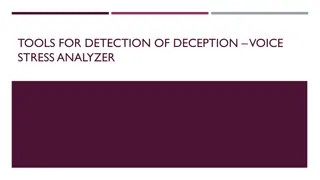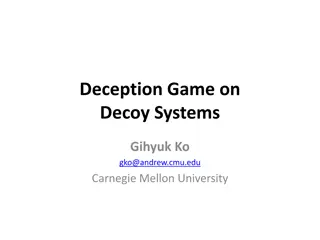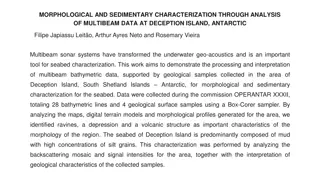Deception Technology: The Art of Creating A Hostile Environment
Deception technology, rooted in the concept of honeypots, strategically misleads malicious actors within a network, allowing for behavior assessment. By implementing this approach, organizations can effectively reduce the attack surface and enhance detection capabilities, creating a hostile environment for potential attackers.
Download Presentation

Please find below an Image/Link to download the presentation.
The content on the website is provided AS IS for your information and personal use only. It may not be sold, licensed, or shared on other websites without obtaining consent from the author.If you encounter any issues during the download, it is possible that the publisher has removed the file from their server.
You are allowed to download the files provided on this website for personal or commercial use, subject to the condition that they are used lawfully. All files are the property of their respective owners.
The content on the website is provided AS IS for your information and personal use only. It may not be sold, licensed, or shared on other websites without obtaining consent from the author.
E N D
Presentation Transcript
Deception Technology There is nothing more deceptive than an obvious fact - Sherlock Holmes
Recent Security Breaches 2021 SolarWinds up to 18,000 customers left vulnerable to hackers because of Vender Email Compromise (VEC) Could cost as much as 100 Billion to clean up the mess! Microsoft email accounts of 30,000 organizations compromised (in 1 day!) through a security flaw in Exchange (attack was carried out by Hafnium, a state sponsored Chinese hacking group). The president of cyber security firm Volexity, which discovered the attack, told Krebs that if you re running Exchange and you haven t patched this yet, there s a very high chance that your organization is already compromised. Ubiquiti, Parler, Facebook, Instagram and LinkedIn on January 11, 2021 multiple attacks all happened in one day 70TB of leaked information from Parler including Drivers Licenses of many of the members! FB, LI & Inst lost over 214 Million records including all their PII. (January 11thwas a big day!) Nebraska Medicine February 2021 - A malware attack allowed a hacker to access and copy files containing the personal and medical information of 219,000 patients of Nebraska Medicine. (Significance is information includes names, addresses, dates of birth, medical record numbers, health insurance information, physician notes, laboratory results, imaging, diagnosis information, treatment information, and/or prescription information, and a limited number of Social Security numbers and driver s license numbers.) California DMV February 2021 - The California Department of Motor Vehicles (DMV) alerted drivers they suffered a data breach after billing contractor, Automatic Funds Transfer Services, was hit by a ransomware attack. The attack exposed drivers personal information from the last 20 months of California vehicle registration records, including names, addresses, license plate numbers and vehicle identification numbers (VINs). (California will now have to fine themselves for data loss!) Compilation of Many Breaches (COMB) - A database containing more than 3.2 billion unique pairs of cleartext emails and passwords belonging to past leaks from Netflix, LinkedIn, Exploit.in, Bitcoin, Yahoo, and more were discovered online. Found in an easily available hacker forum and searchable and well organized. Signifcance is that it s the largest compilation of this kind of data ever found.
Something significant I d like to point out regarding VEC:
Honeypots were the first form of deception technology. IT security researchers started using them in the 1990s, with the intent to deceive malicious actors who had made it onto the network into interacting with a false system. In this way, honeypots could gather and assess the behavior of the malicious actors A new technology using an old strategy: Deception Technology
Deception technology creates a hostile environment for attackers by shrinking the attack surface and deploying deception-based detection. Why use Deception Technology? Being deceptive to hackers is insightful. It builds information that is vital to providing stronger security policies and solutions while minimizing what criminals can do in real time. To be an effective detection tool, deceptions must be inevitable, undetectable and inescapable
How does it work? Decoys appear to be tantalizing targets Security teams receive alerts as soon as these decoys are engaged Security team now has a chance to safely gather data on attackers Decoys come in many forms Artificial Intelligence is used to create these fictitious machines Set policy to react in a wide variety of ways (quarantine, power down, feed misinformation, etc)
Tactics used in deception technology: Honeypots: research versions are placed in the wild to gather information on attacker strategies and motivations, production versions are placed to slow down attackers Honey users: users with implied privileged access planted in the hopes that intruders will attempt to use their log-in which is flagged to alert security upon use Honey credentials: credentials with supposed access rights to larger network; alerts are sent to security if intruders attempt to use the credentials, allowing them to track criminal movement Geo-tracking: files planted with tracking information that is activated upon transfer or opening, sending IP and location data back to security teams Sink-Hole servers: servers that use traffic redirection to trick bots or malware into reporting back to law enforcement or "white hat" researchers instead of criminals
Some of the key points about Deception Technology. Once an attacker is inside the network, today s deception technology gives security teams the earliest and most effective method for detecting and halting an attacker s movements. Deception dramatically increases the effort and costs for the attacker. The next generation of deception technology is smarter and is here now! Automation and machine learning support rapid deployment and touch-free refreshes to maintain deception authenticity. Almost fire and forget and very easy to deploy. Intelligent deception systems can recommend and craft customized network, system, application, server and data deceptions that appear native to the environment. Provides previously unimagined visualization of the attack surface and offers highly efficient detection of cyber threats at the attack beachhead.
Thanks again for having me! Feel free to email me if you have any questions Jon.Davis@SecureNation.net Jon.Davis@SecureNation.net























